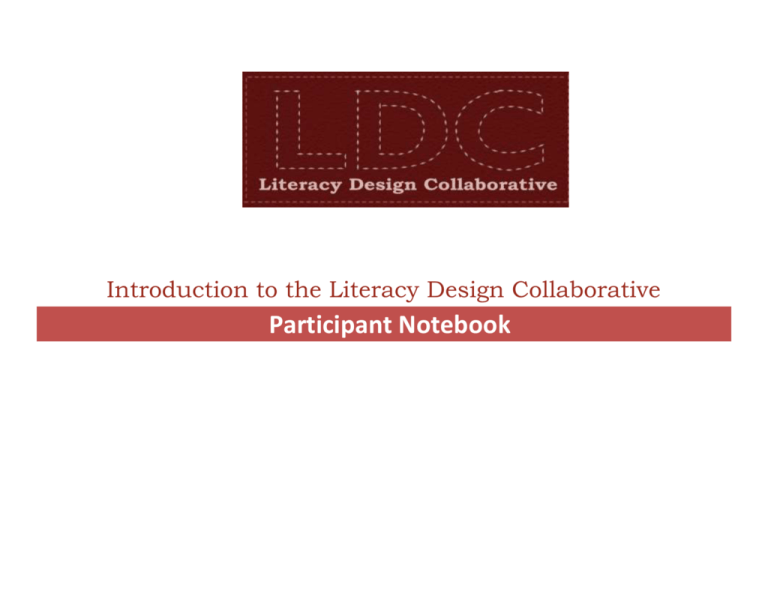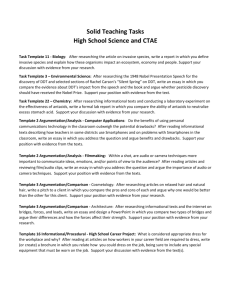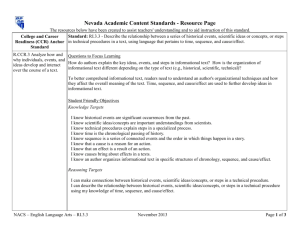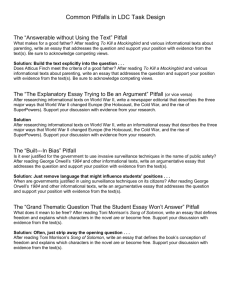LDC Prototype Skills List - Advancing Improvement In Education
advertisement

Introduction to the Literacy Design Collaborative Participant Notebook Activity 1: What does LDC look like? Video: An Example from New York City How is this classroom different from those you have seen? How is reading and writing used as a tool to learn social studies? What is the teacher’s role in this classroom? What is the student’s role in the classroom? What has the teacher done to support/ensure student success? Activity 2: LDC vs. Traditional Describe the differences between the LDC Teaching Task and the Traditional Writing Prompt. Which one is more rigorous? Explain why? Which one is more engaging? Explain why? LDC Teaching Task Traditional Writing Prompt After researching speeches which use persuasive techniques, write a report that defines persuasion and explains its impact on an audience. Support your discussion with evidence from your readings. Using the notes in your journal, write an essay that explains the techniques a writer uses to persuade his audience. After researching selected sources on green technological advances in the automotive industry, write an analysis report that relates how these changes have affected the environment. Support your discussion with evidence from your research Write a report on how automotive technology has changed. After researching the article on invasive species, write an essay that defines invasive species and explains how these organisms impact an ecosystem, economy and people. Support your discussion with evidence from your research. Explain what humans are doing to negatively impact the environment, using examples we discussed in class. After researching primary and secondary sources on problems facing the United States in the 21st century, write a speech that identifies what you believe to be the biggest problem facing American society today and argues for a solution. L2 Be sure to examine competing views. L3 Give examples from past and current events or issues to illustrate and clarify your position. Write a speech that discusses a problem facing America today. What are the possible solutions to this problem? Response Activity 3: Using an LDC Template Task To get a starting sense of how the templates work, please: Choose an issue or a text you enjoy teaching. Individually, try to fill in the Template Task below to make a strong assignment on that subject. (The second copy is to let you try two or start over if you wish.) With a partner, share your drafts and talk through what’s easy and what’s challenging. See if you can make your first tries better together. Task 2 Template (Argumentation/Analysis L1, L2, L3) [Insert question] ________________________________________________________________________________________________________ After reading ______________________________________________________(literature or informational texts), write a/an __________________________________ (essay or substitute) that addresses the question and support your position with evidence from the text(s). L2 Be sure to acknowledge competing views. L3 Give examples from past or current events or issues to illustrate and clarify your position. Task 12 Template (Informational or Explanatory/Definition L1, L2) [Insert question] ________________________________________________________________________________________________________ After reading ______________________________________________________(literature or informational texts), write a/an __________________________________ (essay, report or substitute) that defines ______________________ (term or concept) and explains _________________________________________________ (content). Support your discussion with evidence from the text(s). L2 What _______________________________________ (conclusions or implications) can you draw? Appendix I: Quick Reference Task Chart “After Researching” “Essential Question” Argumentation Template Tasks Analysis Task 1: After researching ________ (informational texts) on ________ (content), write ________ (essay or substitute) that argues your position on ________ (content). Support your position with evidence from your research. L2 Be sure to acknowledge competing views. L3 Give examples from past or current events or issues to illustrate and clarify your position. (Argumentation/Analysis) Task 2: [Insert question] After reading ________ (literature or informational texts), write ________ (essay or substitute) that addresses the question and support your position with evidence from the text(s). L2 Be sure to acknowledge competing views. L3 Give examples from past or current events or issues to illustrate and clarify your position. (Argumentation/Analysis) Task 3: After researching ________ (informational texts) on ________ (content), write ________ (essay or substitute) that compares ________ (content) and argues ________ (content). Be sure to support your position with evidence from the texts. (Argumentation/Comparison) Task 4: [Insert question] After reading ________ (literature or informational texts), write ________ (essay or substitute) that compares ________ (content) and argues ________ (content). Be sure to support your position with evidence from the text/s. (Argumentation/Comparison) Evaluation Task 5: After researching ________ (informational texts) on ________ (content), write ________ (essay or substitute) that discusses ________ (content) and evaluates ________ (content). Be sure to support your position with evidence from your research. (Argumentation/Evaluation) Task 6: [Insert question] After reading ________ (literature or informational texts), write ________ (essay or substitute) that discusses ________ (content) and evaluates ________ (content). Be sure to support your position with evidence from the text/s. (Argumentation/Evaluation) ProblemSolution Task 7: After researching ________ (informational texts) on ________ (content), write ________ (essay or substitute) that identifies a problem ________ (content) and argues for a solution. Support your position with evidence from your research. L2 Be sure to examine competing views. L3 Give examples from past or current events or issues to illustrate and clarify your position. (Argumentation/Problem-Solution) Task 8: [Insert question.] After reading ________ (literature or informational texts) on ________ (content), write ________ (essay or substitute) that identifies a problem ________ (content) and argues for a solution ________ (content). Support your position with evidence from the text(s). L2 Be sure to examine competing views. L3 Give examples from past or current events or issues to illustrate and clarify your position. (Argumentation/ProblemSolution) Cause-Effect Task 9: After researching ________ (informational texts) on ________ (content), write ________ (essay or substitute) that argues the cause(s) of ________ (content) and explains the effect(s) ________ (content). What ________ (conclusions or implications) can you draw? Support your discussion with evidence from the text(s). (Argumentation/Cause-Effect) Task 10: [Insert question] After reading ________ (literature or informational texts) on ________ (content), write ________ (essay or substitute) that argues the cause(s) of ________ (content) and explains the effect(s) ________ (content). What ________ (conclusions or implications) can you draw? Support your discussion with evidence from the text(s). (Argumentation/Cause-Effect) Comparison “After Researching” “Essential Question” Informational or Explanatory Template Tasks Definition Description ProceduralSequential Task 11: After researching ________ (informational texts) on ________ (content), write a ________ (report or substitute) that defines ________ (term or concept) and explains ________ (content). Support your discussion with evidence from your research. L2 What ________ (conclusions or implications) can you draw? (Informational or Explanatory/Definition) Task 13: After researching ________ (informational texts) on ________ (content), write ________ (report or substitute) that describes ________ (content). Support your discussion with evidence from your research. (Informational or Explanatory/Description) Task 12: [Insert question] After reading ________ (literature or informational texts), write ________ (essay, report, or substitute) that defines ________ (term or concept) and explains ________ (content). Support your discussion with evidence from the text(s). L2 What ________ (conclusions or implications) can you draw? (Informational or Explanatory/Definition) Task 15: After researching ________ (informational texts) on ________ (content), write ________ (report or substitute) that relates how ________ (content). Support your discussion with evidence from your research. (Informational or Explanatory/Procedural-Sequential) Task 16: [Insert question] After reading ________ (literature or informational texts) on ________ (content), write ________ (report or substitute) that relates how ________ (content). Support your discussion with evidence from the text(s). (Informational or Explanatory/Procedural-Sequential) Task 14: [Insert question] After reading ________ (literature or informational texts), write ________ (essay, report, or substitutes) that describes ________ (content) and addresses the question. Support your discussion with evidence from the text(s). (Informational or Explanatory/Description) Task 17: After researching ________ (informational texts) on ________ (content), developing a hypothesis, and conducting an experiment examining ________ (content), write a laboratory report that explains your procedures and results and confirms or rejects your hypothesis. What conclusions can you draw? (Informational or Explanatory/Procedural-Sequential) Synthesis Task 18: After researching ________ (informational texts) on ________ (content), write ________ (report or substitute) that explains ________ (content). What conclusions or implications can you draw? Cite at least ________ (number) sources, pointing out key elements from each source. L2 In your discussion, address the credibility and origin of sources in view of your research topic. L3 Identify any gaps or unanswered questions. Optional: Include ________ (e.g. bibliography). (Informational or Explanatory/Synthesis) Task 19: [Insert question] After reading ________ (literature or informational texts), write ________ (essay or substitute) that explains ________ (content). What conclusions or implications can you draw? Cite at least ________ (number) sources, pointing out key elements from each source. L2 In your discussion, address the credibility and origin of sources in view of your research topic. L3 Identify any gaps or unanswered questions. Optional: Include ________ (e.g. bibliography). (Informational or Explanatory/Synthesis) LDC Template Tasks “After Researching” “Essential Question” Informational or Explanatory Template Tasks (Continued Analysis Task 20: After researching ________ (informational texts) on ________ (content), write a ________ (report or substitute) that analyzes ________ (content), providing evidence to clarify your analysis. What conclusions or implications can you draw? L2 In your discussion, address the credibility and origin of sources in view of your research topic. L3 Identify any gaps or unanswered questions. Optional: Include ________ (e.g. bibliography). (Informational or Explanatory/Analysis) Task 21: [Insert question] After reading ________ (literature or informational texts), write ________ (report, essay or substitutes) that addresses the question and analyzes ________ (content), providing examples to clarify your analysis. What conclusions or implications can you draw? L2 In your discussion, address the credibility and origin of sources in view of your research topic. L3 Identify any gaps or unanswered questions. Optional: Include ___ (e.g. bibliography). (Informational or Explanatory/Analysis) ProblemSolution Task 22: After researching ________ (informational texts) on ________ (content), write a ________ (report or substitute) that compares ________ (content). L2 In your discussion, address the credibility and origin of sources in view of your research topic. L3 Identify any gaps or unanswered questions. (Informational or Explanatory/Comparison) Task 23: [Insert l question] After reading ________ (literature or informational texts), write ________ (essay, report, or substitute) that compares ________ (content). L2 In your discussion, address the credibility and origin of sources in view of your research topic. L3 Identify any gaps or unanswered questions. (Informational or Explanatory/Comparison) Cause-Effect Task 24: After researching ________ (informational texts) on ________ (content), write ________ (report or substitute) that examines cause(s) of ________ (content) and explains effect(s) ________ (content). What conclusions or implications can you draw? Support your discussion with evidence from your research. (Informational or Explanatory/Cause-Effect) Task 25: [Insert question] After reading ________ (literature or informational texts) on ________ (content), write a ________ (report or substitute) that examines the cause(s) of ________ (content) and explains the effect(s) ________ (content). What conclusions or implications can you draw? Support your discussion with evidence from the text(s). (Informational or Explanatory/Cause-Effect) Description Task 26: After researching ________ (informational texts) on ________ (content), write ________ (narrative or substitute) that describes ________ (content). L2 Use ___ (stylistic devices) to develop a narrative. L3 Use ___ (techniques) to convey multiple storylines. (Narrative/Description) Task 27: [Insert question] After reading ________ (literature or informational texts) about ________ (content), write ________ (narrative or substitute) from the perspective of ________ (content). L2 Use ________ (stylistic devices) to develop a narrative effect in your work. L3 Use ________ (techniques) to convey multiple storylines. (Narrative/Description) ProceduralSequential Task 28: After researching ________ (informational texts) on_____ (content), write a ________ (narrative or substitute) that relates ________ (content) and the events that ________ (content). L2 Use ________ (stylistic devices) to develop your work. L3 Use ________ (techniques) to convey multiple storylines. (Narrative/Sequential) Task 29: [Insert question.] After reading ________ (literature or informational texts) about ________ (content), write ________ (narrative or substitute) that relates ________ (content). L2 Use ________ (stylistic devices) to develop your work. (Narrative/Sequential) Appendix II Section 2: What Skills? LDC Prototype Skills List (adapted from the Argumentation Module Template) SKILL DEFINITION SKILLS CLUSTER 1: PREPARING FOR THE TASK 1. Task engagement Ability to connect the task and new content to existing knowledge, skills, experiences, interests, and concerns. 2. Task analysis Ability to understand and explain the task’s prompt and rubric. SKILLS CLUSTER 2: READING PROCESS 1. Text selection Ability to identify appropriate texts. 2. Active reading 3. Essential vocabulary Ability to identify the central point and main supporting elements of a text. L2 Ability to identify and analyze competing arguments. L3 Ability to make clarifying connections and/or provide examples. Ability to identify and master terms essential to understanding a text. 4. Academic integrity Ability to use and credit sources appropriately. 5. Note-taking Ability to select important facts and passages for use in one’s own writing. SKILLS CLUSTER 3: TRANSITION TO WRITING 1. Bridging Ability to begin linking reading results to writing task. SKILLS CLUSTER 4: WRITING PROCESS 1. Claim Ability to establish a claim and consolidate information relevant to task. 2. Planning Ability to develop a line of thought and text structure appropriate to an argumentation task. 3. Development Ability to construct an initial draft with an emerging line of thought and structure. L2 Ability to analyze competing arguments. L3 Ability to make clarifying connections and/or provide examples. 4. Revision Ability to refine text, including line of thought, language usage, and tone as appropriate to audience and purpose. 5. Editing Ability to proofread and format a piece to make it more effective. 6. Completion Ability to submit final piece that meets expectations. LDC Template Tasks Appendix III Section 3: What Instruction? (adapted from the Argumentation Module Template) LDC Prototype Instructional Ladder PACING SKILL AND DEFINITION MINI-TASK PRODUCT AND PROMPT SCORING (PRODUCT “MEETS EXPECTATIONS” IF IT …) INSTRUCTIONAL STRATEGIES No Scoring Link this task to earlier class content. Discuss student responses. Clarify timetable and support plans for the task. No scoring Share examples of type of text students will produce (either from past students or from professional writers). Identify or invite students to identify key features of examples. Pair students to share and improve their individual bullets. Create a classroom list: choose one student to share a few ideas on the board, and ask others to add to it. SKILLS CLUSTER 1: PREPARING FOR THE TASK Day 1 Day 1 1. Task engagement Short Response with Bullets Ability to connect the task and new content to existing knowledge, skills, experiences, interests, and concerns. In a quick write, record your first reaction to the task prompt. Add some notes of things you know about this issue. 2. Task analysis Bullets Ability to understand and explain the task’s prompt and rubric. In your own words, what are the important features of a good response to this prompt? Participant Notebook | LDC 9 LDC Template Tasks SKILLS CLUSTER 2: READING PROCESS Day 2 1. Text selection Notes Ability to identify appropriate texts. For each text, list the needed bibliographic information. Add bullets on why you think the work is credible and/or worthy of study. Days 2 and 3 2. Active reading Short reflective entry for each text Ability to identify the central point and main supporting elements of a text. What is the author trying to accomplish? Which parts of the text show you that? L2 Ability to identify and analyze competing arguments. L3 Ability to make clarifying connections or provide examples. Ongoing Provide citation guide and discuss why each element of citation is needed. Ask students to brainstorm what makes an author credible and/or worthy of study. Provide access to research sources for students to assess the texts. Note: for an “after researching” task, add teaching and time for students to select the texts they will use. Invite students to brainstorm ways to figure out any author’s intent. Invite students to share and discuss their answers for each text. After the discussion, allow them to add to their entries. L2 What competing arguments have you encountered or can you think of? L3 What historical or current examples can you note that relate to the task prompt? 3. Essential vocabulary Vocabulary list Ability to identify and master terms essential to understanding a text. In your notebook, list words and phrases essential to the texts. Add definitions, and (if appropriate) notes on connotation in this context. Participant Notebook | LDC Identifies author, title, publisher, date, and any other needed information (for example, the volume for a periodical or the editor for an anthology). Includes reasonable evidence that work is credible and/or worthy of study. Answers questions with credible response. Lists appropriate phrases. Provides accurate definitions. After scoring, ask some students to share definitions of terms that others overlooked or misunderstood. After scoring, be willing to provide direct instruction or guide a close reading if needed to work through a key phrase most students missed. 10 LDC Template Tasks Day 4 Days 4 and 5 4. Academic integrity Definition and strategies Provides accurate definition. Lists several appropriate strategies. Ability to use and credit sources appropriately. Define “plagiarism” and list ways to avoid it. 5. Note-taking Notes Identifies relevant elements. Includes information to support accurate citation (for example, page numbers for a long text, clear indication when quoting directly). Teach a sample format for note taking. Check that early student work is in the assigned format (or in another format that gathers the needed information effectively). Ability to select important facts and passages for use in one’s own writing. From each text, make a list of the elements that look most important for answering the prompt. Do what you need to do to avoid plagiarism. No scoring Discussion-based strategies, such as seminar. Small group discussion using question. Offer several examples of opening paragraphs. Ask class to discuss what makes them strong or weak. Review the list that students created earlier to identify needed elements (from Cluster 1, skill 2). Discuss respect for others’ work to assemble evidence and create texts. Discuss academic penalties for stealing others thoughts and words. SKILLS CLUSTER 3: TRANSITION TO WRITING Day 6 1. Bridging Bullets Ability to begin linking reading results to writing task. In a quick write, note what you know now that you’ve read about _______(content). SKILLS CLUSTER 4: WRITING PROCESS Day 6 1. Claim Opening paragraph Ability to establish a claim and consolidate information relevant to task. Write an opening paragraph that includes a controlling idea and sequences the key points you plan to make in your composition. Participant Notebook | LDC Writes a concise summary statement or draft opening. Provides direct answer to main prompt requirements. Establishes a controlling idea. Identifies key points that support development of argument. 11 LDC Template Tasks Day 7 2. Planning Outline/organizer Ability to develop a line of thought and text structure appropriate to an argumentation task. Create an outline based on your notes and reading in which you state your claim, sequence your points, and note your supporting evidence. L2 Include competing argument(s). L3 Include __ example(s) of historical or current connections to topic/issue. Days 8 and 9 3. Development Initial draft Ability to construct an initial draft with an emerging line of thought and structure. Write an initial draft complete with opening, development, and closing; insert and cite textual evidence. L2 Ability to analyze competing arguments. L3 Ability to make clarifying connections and/or provide examples. Days 10 and 11 L2 Identify competing argument(s). Creates an outline or organizer. Supports opening claim. Uses evidence from texts read earlier. Provide and teach one or more examples of outlines or organizers. Invite students to generate questions in pairs about how the format works, and then take and answer questions. L2 Identifies competing argument(s). L3 Provides appropriate number of sound connections. Provides complete draft with all parts. Supports the opening in the later sections with evidence and citations. Encourage students to re-read prompt partway through writing, to check that they are on track. Provides complete draft with all parts. Supports the opening in the later sections with evidence and citations. Improves earlier edition. Sample useful feedback that balances support for strengths and clarity about weaknesses. Assign students to provide each other with feedback on those issues. L3 Provide appropriate number of sound connections. 4. Revision Multiple drafts Ability to refine text, including line of thought, language usage, and tone as appropriate to audience and purpose. Refine composition’s analysis, logic, and organization of ideas/points. Use textual evidence carefully, with accurate citations. Decide what to include and what not to include. Participant Notebook | LDC 12 LDC Template Tasks Day 12 Day 13 5. Editing Correct Draft Ability to proofread and format a piece to make it more effective. Revise draft to have sound spelling, capitalization, punctuation, and grammar. Adjust formatting as needed to provide clear, appealing text. 6. Completion Final Piece Ability to submit final piece that meets expectations. Turn in your complete set of drafts, plus the final version of your piece. Participant Notebook | LDC Provides draft free from distracting surface errors. Uses format that supports purpose. Fits the “Meets Expectations” category in the rubric for the teaching task. Briefly review selected skills that many students need to improve. Teach a short list of proofreading marks. Assign students to proofread each other’s texts a second time. 13 LDC Template Tasks NOTES _________________________________________________________________________________________________________________________________________________________________ _________________________________________________________________________________________________________________________________________________________________ _________________________________________________________________________________________________________________________________________________________________ _________________________________________________________________________________________________________________________________________________________________ _________________________________________________________________________________________________________________________________________________________________ _________________________________________________________________________________________________________________________________________________________________ _________________________________________________________________________________________________________________________________________________________________ _________________________________________________________________________________________________________________________________________________________________ _________________________________________________________________________________________________________________________________________________________________ _________________________________________________________________________________________________________________________________________________________________ _________________________________________________________________________________________________________________________________________________________________ _________________________________________________________________________________________________________________________________________________________________ _________________________________________________________________________________________________________________________________________________________________ _________________________________________________________________________________________________________________________________________________________________ Participant Notebook | LDC 14







